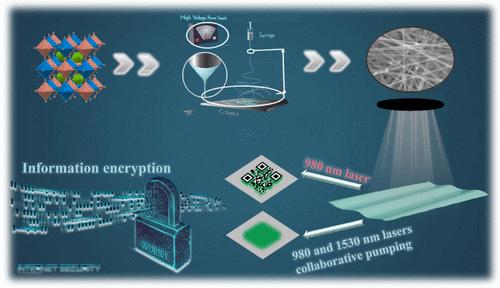Laser-Controlled Information Releasing and Hiding Based on Perovskite Phosphors
IF 8.3
2区 材料科学
Q1 MATERIALS SCIENCE, MULTIDISCIPLINARY
引用次数: 0
Abstract
Laser-active interference with high confidentiality and convenience opens up a cutting-edge path for releasing and hiding key targets; however, its development still faces enormous challenges owing to the difficulty of concealing objects. Herein, a novel conceptual design for laser-controlled information release and hiding (LIRH) is proposed and successfully realized. Cs2NaInCl6:Er3+, Yb3+ (CNIC:Er, Yb) perovskite microcrystal is adopted as a carrier for LIRH implementation, exhibiting excellent up-conversion (UC) emission under NIR (980 and 1530 nm) irradiation due to its ultralow phonon energy. The fluorescence intensity crossover and outstanding photon output capacity are revealed in comparison with Er3+/Yb3+ codoped and Er3+ single-doped CNIC phosphors under different laser sources, and the obvious difference in quantum yields (QY) under 980 and 1530 nm excitation provides theoretical possibility for LIRH. More importantly, the obtained LIRH features high stability at temperatures up to 413 K, showing good adaptability in various potential scenarios. Moreover, CNIC:Er, Yb is further combined with polyacrylonitrile (PAN) polymer to form fluorescent fibers with exceptional crystal stability and composite flexibility, thus making the LIRH code a reality based on perovskite composite phosphors. The laser-active invisibility offers an innovative idea for LIRH, further extending the application of LIRH in the field of information encryption, which has promising prospects in information safety, advanced anticounterfeiting, and smart responsive materials.

基于 Perovskite 磷光体的激光控制信息释放和隐藏技术
具有高保密性和便捷性的激光主动干扰为关键目标的释放和隐藏开辟了一条前沿之路,但由于隐藏对象的困难,其发展仍面临巨大挑战。本文提出并成功实现了一种新型的激光控制信息释放与隐藏(LIRH)概念设计。采用 Cs2NaInCl6:Er3+, Yb3+ (CNIC:Er, Yb)包晶微晶作为实现 LIRH 的载体,由于其具有超低的声子能量,在近红外(980 纳米和 1530 纳米)照射下表现出优异的上转换(UC)发射。与 Er3+/Yb3+ 共掺和和 Er3+ 单掺和 CNIC 磷光体相比,在不同激光源下的荧光强度交叉和出色的光子输出能力得到了揭示,而在 980 和 1530 纳米激发下量子产率(QY)的明显差异为 LIRH 提供了理论上的可能性。更重要的是,所获得的 LIRH 在高达 413 K 的温度下具有很高的稳定性,显示出在各种潜在应用场景下的良好适应性。此外,CNIC:Er, Yb 还与聚丙烯腈 (PAN) 聚合物进一步结合,形成具有优异晶体稳定性和复合灵活性的荧光纤维,从而使基于过氧化物复合荧光粉的 LIRH 代码成为现实。激光主动隐形为 LIRH 提供了一种创新思路,进一步拓展了 LIRH 在信息加密领域的应用,在信息安全、先进防伪和智能响应材料等方面具有广阔的前景。
本文章由计算机程序翻译,如有差异,请以英文原文为准。
求助全文
约1分钟内获得全文
求助全文
来源期刊

ACS Applied Materials & Interfaces
工程技术-材料科学:综合
CiteScore
16.00
自引率
6.30%
发文量
4978
审稿时长
1.8 months
期刊介绍:
ACS Applied Materials & Interfaces is a leading interdisciplinary journal that brings together chemists, engineers, physicists, and biologists to explore the development and utilization of newly-discovered materials and interfacial processes for specific applications. Our journal has experienced remarkable growth since its establishment in 2009, both in terms of the number of articles published and the impact of the research showcased. We are proud to foster a truly global community, with the majority of published articles originating from outside the United States, reflecting the rapid growth of applied research worldwide.
 求助内容:
求助内容: 应助结果提醒方式:
应助结果提醒方式:


